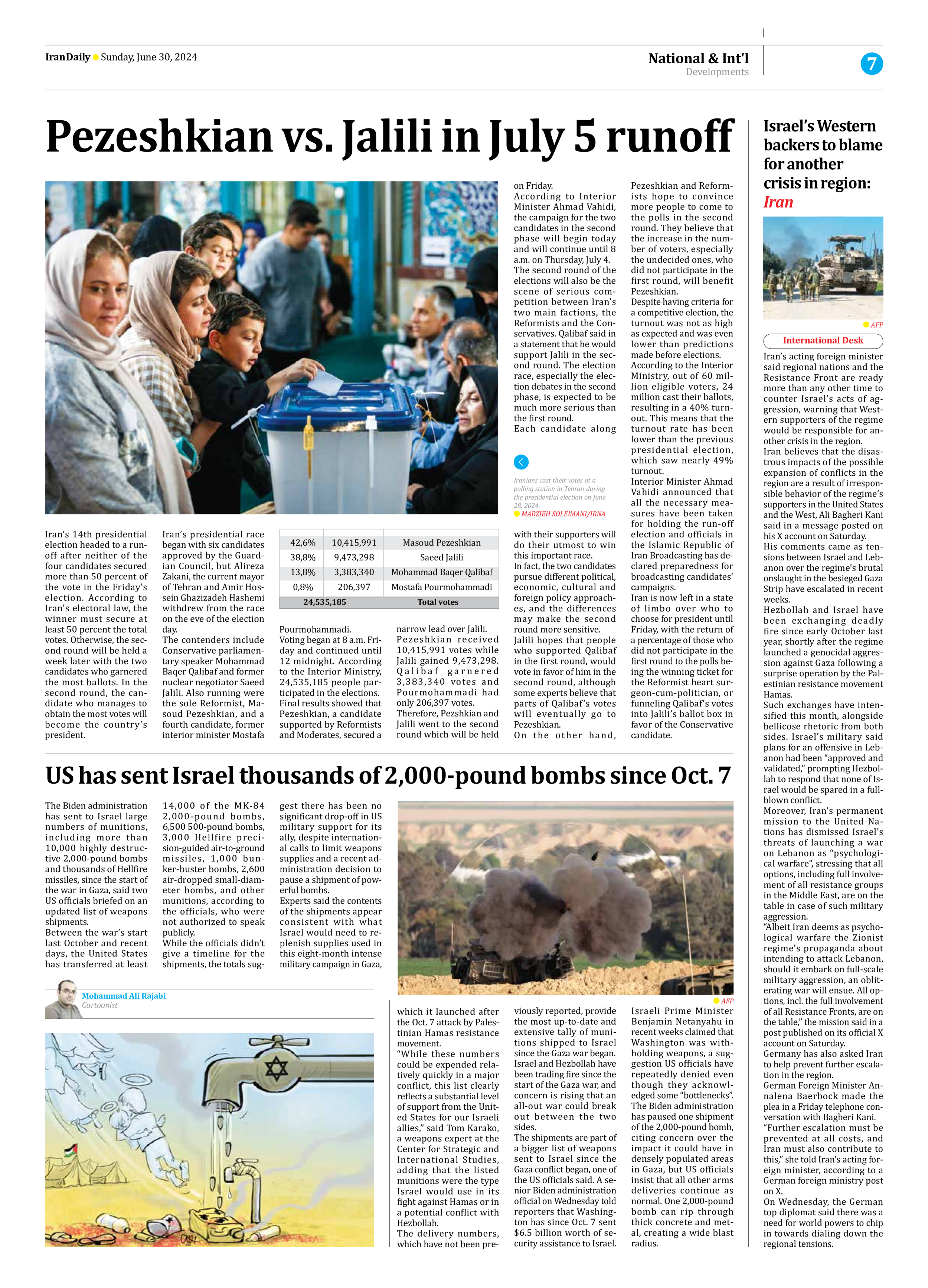
Pezeshkian vs. Jalili in July 5 runoff
Iran’s 14th presidential election headed to a runoff after neither of the four candidates secured more than 50 percent of the vote in the Friday’s election. According to Iran’s electoral law, the winner must secure at least 50 percent the total votes. Otherwise, the second round will be held a week later with the two candidates who garnered the most ballots. In the second round, the candidate who manages to obtain the most votes will become the country’s president.
Iran’s presidential race began with six candidates approved by the Guardian Council, but Alireza Zakani, the current mayor of Tehran and Amir Hossein Ghazizadeh Hashemi withdrew from the race on the eve of the election day.
The contenders include Conservative parliamentary speaker Mohammad Baqer Qalibaf and former nuclear negotiator Saeed Jalili. Also running were the sole Reformist, Masoud Pezeshkian, and a fourth candidate, former interior minister Mostafa Pourmohammadi.
Voting began at 8 a.m. Friday and continued until 12 midnight. According to the Interior Ministry, 24,535,185 people participated in the elections.
Final results showed that Pezeshkian, a candidate supported by Reformists and Moderates, secured a narrow lead over Jalili.
Pezeshkian received 10,415,991 votes while Jalili gained 9,473,298. Qalibaf garnered 3,383,340 votes and Pourmohammadi had only 206,397 votes.
Therefore, Pezshkian and Jalili went to the second round which will be held on Friday.
According to Interior Minister Ahmad Vahidi, the campaign for the two candidates in the second phase will begin today and will continue until 8 a.m. on Thursday, July 4.
The second round of the elections will also be the scene of serious competition between Iran’s two main factions, the Reformists and the Conservatives. Qalibaf said in a statement that he would support Jalili in the second round. The election race, especially the election debates in the second phase, is expected to be much more serious than the first round.
Each candidate along with their supporters will do their utmost to win this important race.
In fact, the two candidates pursue different political, economic, cultural and foreign policy approaches, and the differences may make the second round more sensitive.
Jalili hopes that people who supported Qalibaf in the first round, would vote in favor of him in the second round, although some experts believe that parts of Qalibaf’s votes will eventually go to Pezeshkian.
On the other hand, Pezeshkian and Reformists hope to convince more people to come to the polls in the second round. They believe that the increase in the number of voters, especially the undecided ones, who did not participate in the first round, will benefit Pezeshkian.
Despite having criteria for a competitive election, the turnout was not as high as expected and was even lower than predictions made before elections.
According to the Interior Ministry, out of 60 million eligible voters, 24 million cast their ballots, resulting in a 40% turnout. This means that the turnout rate has been lower than the previous presidential election, which saw nearly 49%
turnout.
Interior Minister Ahmad Vahidi announced that all the necessary measures have been taken for holding the run-off election and officials in the Islamic Republic of Iran Broadcasting has declared preparedness for broadcasting candidates’ campaigns.
Iran is now left in a state of limbo over who to choose for president until Friday, with the return of a percentage of those who did not participate in the first round to the polls being the winning ticket for the Reformist heart surgeon-cum-politician, or funneling Qalibaf’s votes into Jalili’s ballot box in favor of the Conservative candidate.







